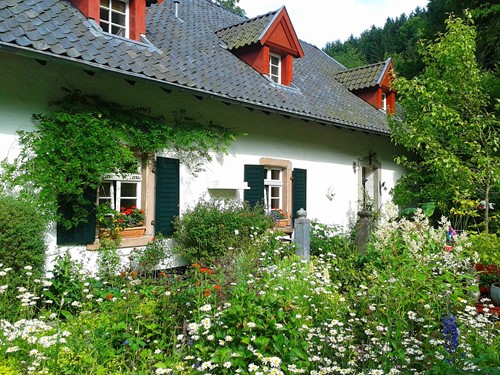
Cottage garden design is a popular landscaping trend originating in late 1800s England. The style idealizes the informal and whimsical aspects of “cottage” life and brings together many details and aesthetics that are still trending today. Here we will go over the key elements of the cottage garden design and some ways you can bring the style home.
Informal & Dense - Cottage gardens are just wild enough to be cozy while still functional. There is very little unused space (no expansive lawns here!) and the wide variety of plant colors and textures create a charming sense of randomness. When designing a cottage garden, avoid symmetry and pattern at all costs in order to create a calculated “mess.”
Natural Materials - Hardscaping in a cottage garden includes natural materials that are rustic while still being accessible. The style celebrates distressed and uneven materials with a preference for brick, stone and gravel for pathways. Go with natural wood and well-worn surfaces for decoration and other features like seating. The key is to stick to the idyllic rural lifestyle without being too rough around the edges.
Blurred Edges - With further regard to edges, a vastly important element of cottage garden style is plants spilling over fences and pathways. This softens barriers and creates an aesthetic both wild and cozy. Trailing vines and large flowering bushes like tea rose are a great way to add cottage charm to fences, gates and other outdoor structures. Allow groundcover to creep onto and in between stones of pathways and let lush shrubs and flowers extend as they naturally would. Just be sure not to impede foot traffic—go for cozy and casual rather than completely overgrown.
Mix of Ornamental & Useful Plants - One element of cottage garden style that has lasted since its originating days is the mixture of decorative, medicinal and edible plants. Adding herbs like rosemary and sage in with the purely ornamental florals is a great way to add texture variety, lush fragrances and practicality to the space. Other common edible plants included in cottage gardens are grapes, blueberries and figs. You can also try planting a fruit tree or two, depending on the space and climate.
Now that you have a better understanding of the basics, here are some ideas you can try in your own garden or outdoor space:
Add a White Lattice Trellis - Trellises are an elegant and useful way to add privacy or define a space. Going with white lattice, either as functional structures or purely decorative elements, will instantly boost the English cottage charm. Add climbing plants like English ivy, climbing rose and clematis to create shade and color. If you’re short on space, simply adding a trellis against an outdoor wall can help create the cottage garden aesthetic with no need for a full garden.
Install Window Boxes - Wooden window boxes are another great way to add functional and beautiful decor to your outdoor space. This is an especially great option if you have limited ground space to work with. Try adding some rustic planter boxes beneath windows and filling them with a variety of your favorite plants and flowers. For the DIY inclined, building your own planters is a relatively simple and rewarding project to add to your garden design.
Cottage garden design is an extremely accessible and informal style that can work for any house or outdoor space. Just stick to these basic elements and it is easy to add that vintage English charm to your modern life.

Kim Clark started her real estate career in 1999 and shortly thereafter obtained her Broker’s license in 2002. After working for larger, corporate offices, she realized that her business and clients needed a more personalized and flexible firm. She founded Bayside Realty Consultants in 2007 offering a space of unity, collaboration and encouragement for agents and their clients. Kim specializes in the unique Cape Cod market comprised of primary, vacation and investment properties.
She says "It is great to be a part of helping make a homeowner's dreams come true". Clients and their individual needs can make things very exciting! Kimberly's enthusiasm is contagious and it has been a real asset in her successful career. She says, "Never quit. Just do what you like and the rest just falls into place." She is certified in several real estate designations including GRI, CBR, CRS, e-Certified, and a certified trainer.